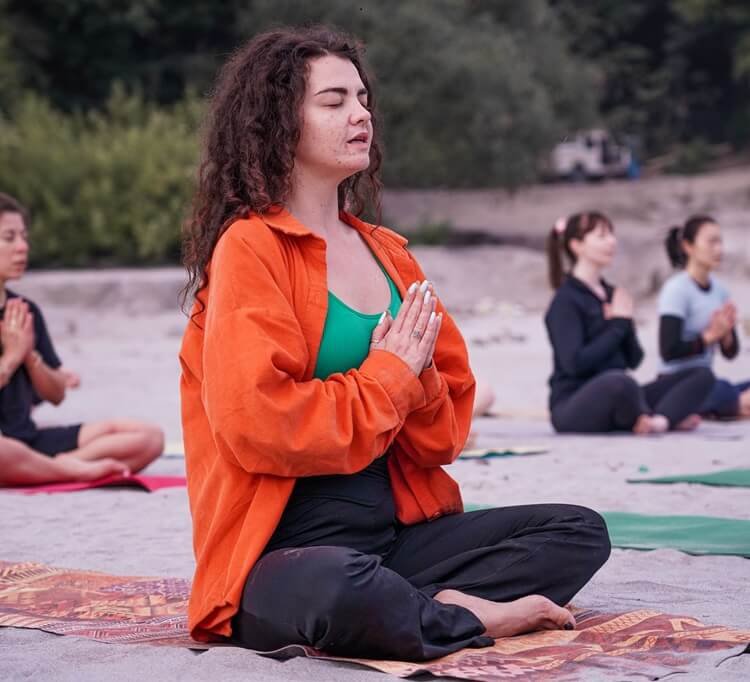Sanskrit Names for Yoga Poses: Unearthing the Roots of Yogic Tradition

Yoga is a practice that unites the mind, body, and soul. It originated in ancient India. The language of the gods, as it is often called, the Sanskrit language is deeply rooted in yoga traditions. The Sanskrit names for yoga poses are full of meaning and represent the spiritual essence of each posture.
Understanding these names connects practitioners more deeply with the philosophy and history of yoga. Delve deeper into the subject of yoga with a greater degree of familiarity to these names as associated with yoga poses. Learn more on how you can achieve this as you explore in detail on these names as mentioned in this article.
More than mere names, sanskrit words for yoga poses embody the concept of posture. "Adho Mukha Svanasana" is a Downward Facing Dog; that's what it resembles: a stretching dog. Each name reveals a story or holds a deeper meaning and thereby amplifies the meditative essence of yoga. The more global contemporary yoga grows, the more it needs these terms to ensure its genuineness remains preserved.
This article will introduce Sanskrit names for yogic poses, trace out their linguistic and cultural significances, and highlight their connection with yogic asanas. From the wellknown postures like "Tadasana" (Mountain Pose) to complex asanas, mastering those names enriches one's experience in the practice of yoga. Whether one is a beginner or an advanced practitioner, engaging with the Sanskrit language does deepen the connection to this practice.
Also Read: Meaning of Hanuman Chalisa
Significance of Sanskrit Names for Yoga Poses
Sanskrit is considered to be one of the oldest languages in the world with a very precise and rhythmic structure. In yoga, it is used as a link between the physical and spiritual worlds. Each name stands for not only the physical alignment of the pose but also its energetic and symbolic meaning.
For instance, "Vrksasana" (Tree Pose) represents balance and growth while "Shavasana" (Corpse Pose) is an invitation to surrender and stillness. Such names remind the practitioner that yoga is a holistic journey, merging physical strength, mental focus, and spiritual awareness.
Read Also: What is a Moon Salutation in Yoga?
Common Yogasana Postures with Sanskrit Names
With the inclusion of Sanskrit yoga pose names, you absorb the timelessness of a practice transcending the physical to connect with the spiritual plane in yoga. May this inform your practice and make you deepen your love for this age-old art.
- Standing Poses (Tadasana and More)
- Tadasana (Mountain Pose): It is the foundational pose that means stability and grounding. "Tada" means mountain, which emphasizes strength and balance.
- Virabhadrasana (Warrior Pose): Named after the mythological warrior Virabhadra, this pose embodies courage and determination.
- Utkatasana (Chair Pose): "Utkata" means intense, which reflects the powerful engagement required.
- Seated Poses
- Padmasana (Lotus Pose): A meditative pose symbolizing purity and enlightenment.
- Sukhasana (Easy Pose): A simple seated position that promotes relaxation and mindfulness.
- Backbends
- Bhujangasana (Cobra Pose): Like the curve of the cobra, this pose opens the heart and strengthens the spine.
- Ustrasana (Camel Pose): A deep heartopening posture, representing vulnerability and expansion.
- Forward Bends
- Paschimottanasana (Seated Forward Bend): This is a contemplative stretch for the spine and hamstrings.
- Uttanasana (Standing Forward Bend): A grounding pose that calms the mind.
- Balancing Poses
- Vrksasana (Tree Pose): It is a standing pose that develops concentration and stability just like a tree that stands tall in the wind.
- Garudasana (Eagle Pose): A twisting pose that develops concentration and strength.
- Inversions
- Adho Mukha Svanasana (DownwardFacing Dog): Stretching and strengthening the body, is a symbol of surrender.
- Sirsasana (Headstand): The king of all poses, which reverses the flow of energy.
Why Learn Yogasana Postures with Name?
Learning yoga asanas in Sanskrit helps practitioners connect with yoga's spiritual foundation. These names are steeped in cultural and historical significance, offering insights into the philosophy behind each posture. For teachers, using Sanskrit terms fosters authenticity in classes, helping preserve yoga's ancient heritage.
Moreover, the rhythmic pronunciation of yoga postures sanskrit terms has a meditative quality, aligning with yoga’s goal of achieving inner peace. For instance, chanting "Shavasana" can deepen relaxation, while saying "Virabhadrasana" can inspire strength.
Read Also: Solar Plexus Chakra Affirmations
How to Remember Sanskrit Terms for Yoga Poses?
Understanding the Meaning of yoga poses and sanskrit names while relating the name to the pose's appearance or purpose makes it easier to remember.
- Use Flashcards: Write the Sanskrit names on one side and the English translations on the other.
- Practice Regularly: Repetition during your yoga sessions reinforces memory.
- Learn Pronunciation: Listening to native speakers or yoga teachers helps with accurate pronunciation.
Embrace the Heritage of Yoga
The Sanskrit names for yoga poses are a testament to yoga's rich history and spiritual depth. Learning and using these terms honors the practice's origins and deepens your connection to its philosophy. Whether you're exploring basic poses or mastering advanced asanas, understanding yoga postures in Sanskrit enriches your journey.
Start integrating these yoga asanas and names into your practice today and experience a more profound connection to yoga's essence. Let the language of Sanskrit guide your path to mindfulness and self-discovery.
Read Also: Yoga Poses for Two People
Commonly Inquired Questions
Sanskrit reflects yoga's Indian heritage, linking physical postures with spiritual meanings.
Some starting poses can be common poses, using flashcards to familiarize oneself with terms and practice pronunciation with teachers or online resources.
Tadasana (Mountain Pose), Sukhasana (Easy Pose), and Balasana (Child's Pose) are great for beginners.
Not all classes, however, but traditional schools will insist on Sanskrit to enhance authenticity.
No, but learning these words will add to an understanding and appreciation of the origins of yoga.
"Asana" means "to sit" or "to support," meaning a sitting and stable position in yoga.
What's Your Reaction?
























